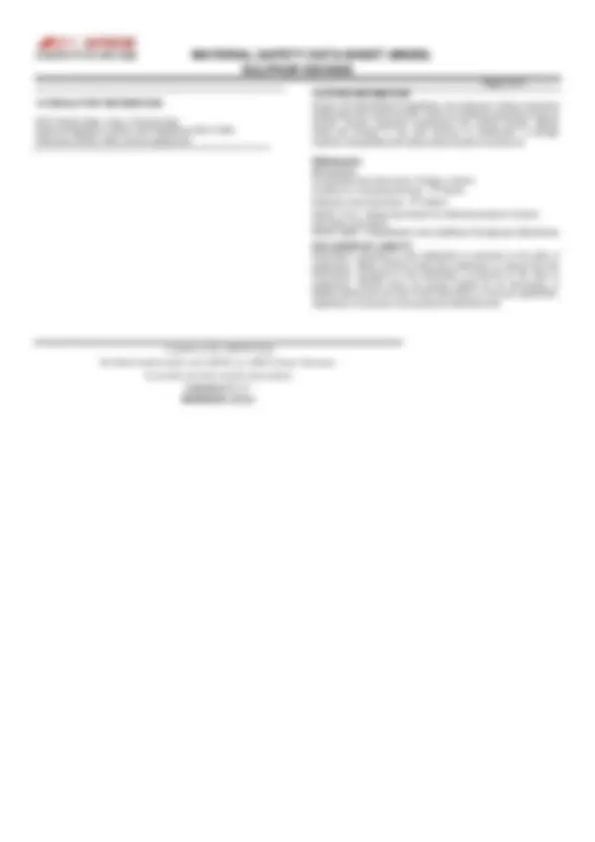



Study with the several resources on Docsity

Earn points by helping other students or get them with a premium plan


Prepare for your exams
Study with the several resources on Docsity

Earn points to download
Earn points by helping other students or get them with a premium plan
Community
Ask the community for help and clear up your study doubts
Discover the best universities in your country according to Docsity users
Free resources
Download our free guides on studying techniques, anxiety management strategies, and thesis advice from Docsity tutors
Important information about the hazards, handling, storage, and first aid measures for sulphur dioxide. It includes details on the product identification, hazard identification, composition, first aid measures, and physical and chemical properties of sulphur dioxide.
Typology: Schemes and Mind Maps
1 / 3

This page cannot be seen from the preview
Don't miss anything!


Page 1 of 3 DATE: April 2017 Version 3 Ref. No.: MS 026 1 PRODUCT AND COMPANY IDENTIFICATION Product Names SULPHUR DIOXIDE Synonym Sulfurous Acid Anhydride Chemical Formula SO 2 Trade Name Sulphur Dioxide Colour coding Brunswick green (H.O7) body with a Golden yellow (B49) shoulder Valve CGA 240 – Steel 3/8 inch 18 NGT right hand female Company Identification African Oxygen Limited 23 Webber Street Johannesburg, 2001 Tel. No: (011) 490- 0400 Fax No: (011) 490- 0506 Emergency Number 0860 020 020 or 0860 111 185 [24 hours] 2 HAZARDS IDENTIFICATION Main Hazards All cylinders are portable gas containers, and must be regarded as pressure vessels at all times. Sulphur dioxide is a highly irritating gas; it readily elicits respiratory reflexes. It is intensely irritating to the eyes, throat, and respiratory tract. Adverse Health effects Inhalation of this gas in concentrations of 8-12ppm in air causes throat irritation, coughing, constriction of the chest, lachrimation, and smarting of the eyes. A concentration of 150 ppm can be endured only a few minutes, because of eye irritation and the effect on the membranes of the nose, throat and lungs. Exposure to a concentration of 500 ppm by volume in air for a few minutes is very dangerous. Chemical hazards Sulphur dioxide dissolves in water forming sulphurous acid, which is unstable toward heat. In many of its reactions, sulphur dioxide behaves as a reducing agent. Biological Hazards Liquid Sulphur dioxide may cause skin and eye burns upon contact with these tissues, which results from the freezing effect of the liquid on the skin or eyes. Low (1%) concentrations of the vapour are irritating to moist skin within a period of 3 minutes. Vapour Inhalation Acute exposure through inhalation may result in dryness and irritation of the nose and throat, choking, sneezing, coughing, and bronchospasm. Severe overexposure may cause death through systemic acidosis, from pulmonary oedema, or from respiratory arrest. Eye Contact Corneal burns, opacification of the cornea, and blindness may result if liquid Sulphur dioxide is splashed in the eyes. Sulphur dioxide can penetrate the intact cornea and cause iritis. Skin Contact Liquid sulphur dioxide can cause frostbite and skin burns, and it converts to sulphurous acid in moist environments, which may cause skin irritation. Ingestion Severe burns to the mouth, throat, and gastrointestinal system may occur. 3 COMPOSITION/INFORMATION ON INGREDIENTS Chemical Name Sulphur Dioxide Chemical Family Inorganic, acidic gas CAS No. 7446 - 09 - 5 UN No. 1079 ERG No. 125 Hazchem Warning Toxic and corrosive gas 4 FIRST AID MEASURES Move victims of sulphur dioxide inhalation to fresh air. If breathing has ceased, begin artificial respiration immediately. Administer oxygen if exposure has been severe and breathing is difficult. Skin exposure first aid treatment includes flushing the contaminated skin with copious amounts of water, and continuing as required in order to control burning sensation. Medical attention should be sought if irritation persists, or if skin is broken or blistered. In the event of eye contact, flush eyes immediately with copious amounts of water for at least 15 minutes. Eyelids should be held apart to ensure complete irrigation. Seek medical attention immediately. 5 FIRE FIGHTING MEASURES Extinguishing Media As sulphur dioxide is non-flammable, the correct extinguishing media should be used for the surrounding fire. Specific Hazards Water should never be sprayed at or into a tank or system which is leaking sulphur dioxide. The presence of water causes sulphur dioxide to be very corrosive, and water directed into a tank would also increase the venting rate. Emergency Actions A sulphur dioxide container exposed to a fire should be removed. If for any reason it cannot be removed, the container should be kept cool with a water spray until well after the fire is out. Fire fighting personnel should be equipped with protective clothing and respiratory equipment. CONTACT THE NEAREST AFROX BRANCH. Protective Clothing Exposed fire fighters should wear approved self- contained breathing apparatus with full face mask. Environmental Precautions When sulphur dioxide is released to the environment, the appropriate regulatory agency should be notified. In the event of a release however, provincial, municipal, and/or local reporting regulations must be complied with. It is most important that the response groups in the area affected be notified as quickly as possible. 6 ACCIDENTAL RELEASE MEASURES Personal Precautions It is essential that every facility handling sulphur dioxide has an emergency plan outlining the actions that employees should take in case of specific emergencies. These actions should include alerting fellow employees and area emergency control groups of the nature and extent of the emergency. The plan should also include co- ordination procedures with area emergency control groups in the event of a major release. If, despite all precautions, persons should become trapped in a sulphur dioxide atmosphere, they should breathe as little as possible and open their eyes only when necessary. Partial protection may be gained by holding a wet cloth over the nose and mouth. Environmental Precautions Only personnel trained for and designated to handle emergencies should attempt to stop a leak. Respiratory equipment of a type suitable for sulphur dioxide must be worn. All persons not so equipped must leave the affected area until the leak has been stopped.
Small spills If sulphur dioxide is released, the irritating effect of the vapour will force personnel to leave the area long before they have been exposed to dangerous concentrations. Sulphur dioxide is fairly soluble in cool water and therefore the vapour concentration can be reduced by the use of spray or fog nozzles. If disposal of sulphur dioxide becomes necessary, such as from a leaking container or vessel, it can be vented into a lime or caustic soda solution. The resulting salt solution should be taken to a plant treating unit for neutralisation and disposal. Large spills See “Personal Precautions” above. 6 HANDLING AND STORAGE Sulphur dioxide should be handled only in a well-ventilated area, preferably a hood with forced ventilation. Personnel handling sulphur dioxide should wear chemical safety goggles and/or plastic face shields, approved safety shoes, and rubber gloves. Additional gas masks, air-line gas masks, and self- contained breathing apparatus should be conveniently located for use in emergencies. Instant-acting safety showers should be available in convenient locations. Cylinders should always be transported in the upright position, with the valve uppermost, and be firmly secured. Use the “first in - first out” inventory system to prevent full cylinders from being stored for excessive periods of time. Compliance with all relevant legislation is essential. Keep away from children. 8 EXPOSURE CONTROLS/PERSONAL PROTECTION Occupational exposure hazards Prolonged or repeated exposure may cause impaired lung function, bronchitis, hacking cough, nasal irritation and discharge, increased fatigue, alteration in the sense of taste and smell, and longer duration of common colds. TLV 2 ppm STEL (15 minutes) 5 ppm IDLH 100 ppm Engineering control measures Engineering control measures are preferred to reduce exposures. General methods include mechanical ventilation, process or personal enclosure, and control of process conditions. Administrative controls and personal protective equipment may also be required . Personal protection Use an approved gas mask or self contained breathing apparatus when entering a sulphur dioxide contaminated area. Eyes Wear a chemical safety goggle or full face shield when handling cylinders. Hands Wear suitable protective gloves when handling cylinders. Feet Wear protective foot wear when working with cylinders. Skin Wear suitable protective clothing to prevent the gas from coming into direct contact with skin. 9 PHYSICAL AND CHEMICAL PROPERTIES PHYSICAL DATA Chemical Symbol SO 2 Molecular Weight 64, Specific volume @ 20°C & 101,325 kPa 366.9 ml/g Relative density of gas @ 101,325 kPa (Air = 1) 2, Boiling point @ 101,325 kPa - 10°C Colour None Taste Acidic Odour Pungent, Sulphurous Page 2 of 3 10 STABILITY AND REACTIVITY Conditions to avoid Overheating of cylinders. Never use cylinders as rollers or supports; or for any other purpose than the storage of sulphur dioxide. Incompatible Material Moist sulphur dioxide is corrosive to carbon steel; therefore, other materials of construction have to be considered in this case. Hazardous Decomposition Products Sulphur dioxide is not flammable, or explosive, in either the gaseous or liquid state. It is a relatively stable chemical. Temperatures above 2000ºC are required to bring about detectable decomposition of sulphur dioxide. 11 TOXICOLOGICAL INFORMATION Acute Toxicity In extreme cases, dental cavities, loss of fillings, gum disorders, and the rapid and painless destruction of teeth may result from repeated overexposure. See section 3. Skin & eye contact See Section 3 Chronic Toxicity See Section 3 Carcinogenicity No known effect Mutagenicity No known effect Reproductive Hazards No known effect 12 ECOLOGICAL INFORMATION Environment Poses a severe hazard to the ecology in the form of “acid rain”. 13 DISPOSAL CONSIDERATIONS Disposal Methods Due to the complexity and scope of sulphur dioxide disposal procedures, care must be taken to ensure that all existing regulations are complied with. For more detailed information or guidance. CONTACT THE NEAREST AFROX BRANCH. 14 TRANSPORT INFORMATION ROAD TRANSPORTATION UN No. 1079 Class 2. Subsidiary risk Toxic and corrosive gas ERG No 125 Hazchem warning Toxic and corrosive gas SEA TRANSPORTATION IMDG 1079 Class 2. Label Toxic gas AIR TRANSPORTATION ICAO/IATA Code 1079 Class 2. Subsidiary risk Toxic and corrosive gas Packaging instructions